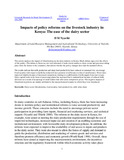| dc.contributor.author | Nyariki, Dickson M. | |
| dc.date.accessioned | 2017-02-25T07:41:38Z | |
| dc.date.available | 2017-02-25T07:41:38Z | |
| dc.date.issued | 2009 | |
| dc.identifier.uri | http://hdl.handle.net/123456789/214 | |
| dc.identifier.uri | http://www.lrrd.org/lrrd21/10/nyar21165.htm | |
| dc.identifier.uri | http://erepository.uonbi.ac.ke/handle/11295/28164 | |
| dc.identifier.uri | https://www.researchgate.net/publication/289815596_Impacts_of_policy_reforms_on_the_livestock_industry_in_Kenya_The_case_of_the_dairy_sector | |
| dc.identifier.uri | https://www.semanticscholar.org/paper/Impacts-of-policy-reforms-on-the-livestock-industry-Nyariki/bb50be18639b074839584a58385d068095c26b5c | |
| dc.description.abstract | This article analyses the impact of liberalization on the dairy industry in Kenya. Much debate rages over the effects of this policy. This debate is, however, not well informed; it lacks recent studies to show events and processes taking place from the farmer to the consumer, that inform whether the policy changes have had the intended effects. The results indicate that milk production and dairy herd productivity have reduced or remained low, on average. Food security with respect to milk has reduced from a position of sufficiency to that of insufficiency. Prices have improved slightly because of increased competition, leading to a stabilization of milk supply from year to year. Dairy capital stock in the form of processing plants has increased but is underutilized because of reduced milk deliveries as a result of an upsurge of small traders that offer more competitive prices. The negative impacts of liberalization policies are mainly attributed to the unsynchronized manner in which they were introduced. | en_US |
| dc.language.iso | en | en_US |
| dc.subject | food security | en_US |
| dc.title | Impacts of policy reforms on the livestock industry in Kenya: The case of the dairy sector | en_US |
| dc.type | Article | en_US |

